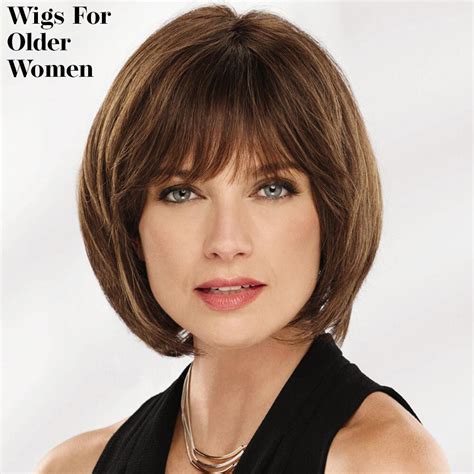Aging gracefully can be a beautiful journey, but it often comes with its fair share of challenges. One of these is hair loss, which can significantly impact a woman’s self-esteem and confidence. Wigs offer a fantastic solution to this problem, restoring hair volume, style, and confidence.

Types of Wigs for Elderly Women
-
Synthetic Wigs: Made from artificial fibers, these wigs are affordable, easy to style, and heat-resistant up to 350°F.
-
Human Hair Wigs: Crafted from real human hair, these wigs are more expensive but offer a natural look and feel, can be dyed, and heat-styled up to 450°F.
-
Lace Front Wigs: These wigs feature a sheer lace that blends seamlessly with the wearer’s skin, creating a realistic and natural-looking hairline.
-
Monofilament Wigs: With a sheer base that allows for better ventilation, these wigs are lightweight, comfortable, and breathable.
Wig Care and Maintenance
-
Washing: Wash wigs with gentle shampoo and lukewarm water. Avoid using harsh chemicals or conditioners.
-
Conditioning: Condition the wigs with a leave-in conditioner to keep them soft and manageable.
-
Styling: Use heat tools (e.g., hair dryer, curling iron) sparingly and on low heat to avoid damaging the fibers.
-
Storage: Store wigs on a wig stand or in a cool, dry place. Avoid hanging them or storing them in direct sunlight.
Choosing the Right Wig
-
Face Shape: Determine your face shape (e.g., oval, square, round) to choose a wig that complements your features.
-
Hair Texture: Match the texture of your wig to your natural hair, considering factors like curl pattern and thickness.
-
Color: Opt for a wig color that flatters your skin tone and matches your desired look.
-
Style: Select a wig style that suits your personal preferences and lifestyle, considering length, volume, and level of styling required.
Benefits of Wigs for Elderly Women
-
Enhanced Appearance: Wigs restore hair volume, hiding hair loss and improving overall appearance.
-
Regained Confidence: A flattering wig can boost confidence, making women feel more attractive and vibrant.
-
Improved Well-Being: Studies have shown that wigs can reduce stress, anxiety, and depression associated with hair loss.
Exceptional Wigs for Elderly Women
-
Raquel Welch’s Epic Wig: A captivating synthetic wig with elegant, voluminous layers and a natural hairline.
-
Jon Renau’s Top Form Monofilament Wig: A lightweight human hair wig that combines comfort, breathability, and a realistic look.
-
Rene of Paris’ Elle Monofilament Lace Front Wig: A sophisticated lace front wig that mimics natural hair growth and allows for versatile styling.
-
Amore’s Amore Mio Collection: A collection of synthetic wigs designed specifically for women with thinning hair or alopecia, featuring soft, breathable materials.
Tips for Wearing Wigs Comfortably
-
Secure the Wig Properly: Use wig caps and combs to stabilize the wig on your head and prevent slippage.
-
Moisturize Your Scalp: Apply scalp lotion or use dry shampoo to absorb moisture and prevent irritation.
-
Take Breaks: Remove the wig for short periods throughout the day to allow your scalp to breathe.
Frequently Asked Questions (FAQs)
-
Can I wear a wig with my own hair? Yes, you can use a wig cap or bobby pins to blend your natural hair with the wig.
-
How often should I wash my wig? The frequency depends on the type of wig. Synthetic wigs require less washing, while human hair wigs may need to be washed more often.
-
Can I color my wig? Human hair wigs can be dyed with permanent or semi-permanent hair dye. However, it’s not recommended to dye synthetic wigs.
-
How long do wigs last? Synthetic wigs typically last 6-8 months with proper care, while human hair wigs can last for years.
-
Can I swim with a wig? Yes, but it’s important to use a swim cap to protect the wig from chlorine and salt water.
-
Can I exercise with a wig? Yes, but it’s essential to secure the wig tightly to prevent it from coming off.
